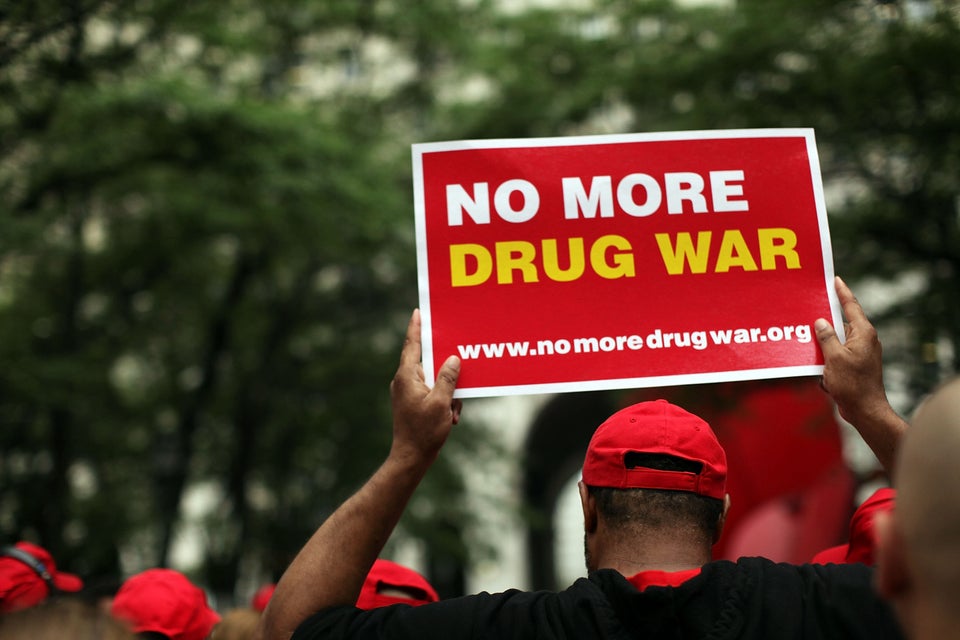Americans spent roughly $1 trillion on illegal substances between 2000 and 2010, a new report compiled for the White House shows.
The report, published by the RAND Drug Policy Research Center for the Office of National Drug Control Policy, tracked the total expenditures, consumption and number of users of marijuana, cocaine (including crack), heroin and methamphetamine. While the demand for certain drugs varied over the course of the decade, overall spending on illegal substances remained consistent at roughly $100 billion per year.
Over the same time period, the U.S. government spent between $40 billion and $50 billion each year fighting the war on drugs. Despite these efforts, Americans' spending levels on illegal drugs stayed more or less the same.
Given the magnitude of the resources involved in fighting drug use in America, Jonathan Caulkins, co-author of the study and professor of public policy at Carnegie Mellon University, told The Huffington Post that the right question to ask in the face of this data is not "Is drug use going down?" Rather, he said, experts should examine how current levels of drug use compare to what they would be under legalization.
"We have spent more on the war on poverty than we have in the war on drugs, and poverty rates haven't fallen as much in 48 years as cocaine use has fallen in the last six," Caulkins said. "You don't conclude from that that welfare programs should be cancelled."
But Ethan Nadelmann, executive director of the Drug Policy Alliance, told HuffPost that these figures illustrate what a "crazy policy" the U.S. has adopted toward drugs and drug users. Due to the federal government's stance on these substances, users are forced to buy them at elevated, black-market prices, which in turn makes criminal enterprises all the richer.
"Prohibitionist policies effectively impose a value added tax on certain drugs that is enforced by the government at great expense and collected by criminals at great profit," Nadelmann said. "That's a key reason why most American citizen-taxpayers now favor legalizing and taxing marijuana."
Although the demand for illicit substances remained steady over the past decade, different drugs were popular at different times. Marijuana consumption increased more than 30 percent between 2006 and 2010, while cocaine consumption dropped by about 50 percent. Throughout the 10-year period, heroin consumption remained relatively stable, although the study suggests a possible increase in later years of the decade. For all the drugs studied in the report, the total consumption and money spent were driven primarily by the minority of heavy users who consume these drugs on 21 or more days per month.
The study's authors said their methodology didn't capture the reasons for changes in drug users' consumption habit, but there's a report in the works that will.
"We're currently working on an article that walks through possible explanations for the big changes in cocaine and marijuana consumption," Beau Kilmer, the report's lead author and co-director of the RAND Drug Policy Research Center, told HuffPost.
Caulkins said that examining those changes is critical for public policy. "It illustrates why it's dangerous to just presume that what we knew in 2000 or 2005 remains a sufficient basis for forming good policy today," he said. "One shouldn't get too worked up about particular numbers, but when converted to human terms -- of deaths, overdoses leading to emergency department visits, including the literally millions of people who daily struggle with abuse and addiction -- it remains a large source of pain and suffering even if there has not been growth overall over the past decade."
Caulkins added that it's impossible to tell whether the current national trend toward marijuana legalization is directly related to the rise in pot use. Twenty states and the District of Columbia have legalized marijuana for medical use, and Washington and Colorado approved recreational legalization in 2012.
"It is entirely possible that the correlation reflects a causal relationship," said Caulkins. "But there is no way to know in any formal scientific sense. I would guess that there are two distinct causal pathways at play: Relaxed laws cause greater use, and greater cultural [and] social acceptance -- a 'softening' of attitudes and perceptions of harms -- causes both greater use and more lenient policies."
Because the study's timeline concluded in 2010, it doesn't take into account recreational marijuana use in Colorado and Washington, or the recent rise in heroin use and overdoses.
And researchers say that this may be the last time a report of this depth can be compiled. Many of the estimates of heroin, cocaine and methamphetamine consumption were based on data from the Arrestee Drug Abuse Monitoring (ADAM) program, which is no longer funded by the federal government.
"For years, ADAM has been the most important data source for estimating the number of heavy hard drug users and how much they spend," Kilmer said. "This information is not only critical for making smart decisions about treatment, but it is important for calculating revenues going to criminal organizations. Cutting ADAM today makes it very difficult to generate these figures in the future."

